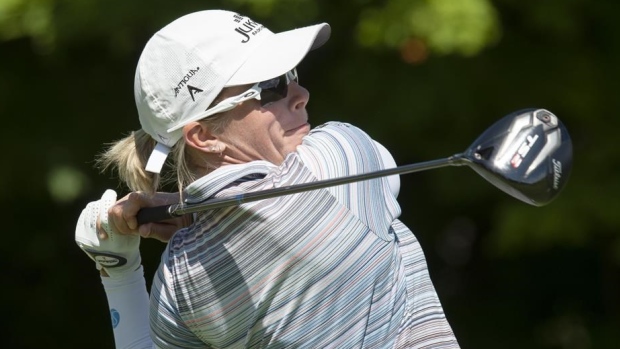Apr 30, 2020
Sharp anxious to get back on the course
The veteran Canadian LPGA Tour player gearing up for an aggressive golf calendar that has tournaments until late December with little time off, Bob Weeks writes.
By Bob Weeks

Like a lot of people, Alena Sharp is being forced indoors these days. That’s in large part due to the Coronavirus pandemic, but it’s also because of a sweltering heat wave in her home of Chandler, Ariz., where the temperatures have soared to 40 degrees.
Understandably, the veteran Canadian LPGA Tour player has been off the links recently, lacking any inspiration to work on her game.
“The golf courses are open, but a couple of weeks ago I was just not enjoying being out there not knowing when we’re going to start, not having a lot of motivation,” she said. “So, I took a good week off.”
But on Wednesday, LPGA Tour commissioner Mike Whan released the circuit’s planned new schedule, which will start July 18 at the Dow Great Lakes Bay Invitational in Midland, Mich. It’s an aggressive calendar that has tournaments until Dec. 20 with just two off weeks.
“It’s a long wait until the first event and then I think we’ll be playing for five months straight,” noted Sharp, who returned to practising last week. “It’s a matter of being patient now and getting the rest for a really big schedule until the end of the year.”
There will still be a lot of questions for the players, including how much to play and where to travel. The schedule includes stops in France, Scotland, England, China, South Korea, Japan and Canada for the CP Women’s Open, slated for Sept. 3-6 in Vancouver.
“Do we go to Europe this year?” Sharp questioned. “I’m not feeling like I want to go Europe, but that means not playing in two majors.”
There’s also no telling what international travel will look like in the summer and fall. In some cases, the decisions may be out of the players’ hands.
When play does resume, Sharp expects it to be with no fans and without many of the extras that usually accompany tour stops.
“It’s going to look bare bones to begin with,” she said. “I think it will be a minimal number of people around, and then as things get better, we can institute things and make it look more like a normal golf tournament. One of my friends said we’d really learn to appreciate what tour life is all about.”
The tour is trying to accommodate as many players as possible and with as large a purse at each event as it can muster. The purses at many of the remaining events will be boosted, in some cases thanks to money offered from sponsors of events that have been cancelled.
The total available prize pool remaining for the year is more than $56 million, with players competing for an average of nearly $2.7 million per event.
That’s welcome news on a circuit that doesn’t offer up the riches of the PGA Tour. Sharp said that the lack of play is likely starting to hit the pocketbooks of some of the golfers.
“I think maybe it’s starting to affect people now,” she said. “Maybe not so much the first month. We are saving money by not having expenses because it’s about $3,000 a week to play. But I do feel like the younger players and the rookies are really feeling it right now.”
The players aren’t the only ones being impacted financially. In a teleconference on Wednesday, Whan admitted that the tour has taken a significant hit.
“It's a staggering financial impact year,” he said. “It's not – it doesn't take us to our knees. It doesn't put us on a death watch, but I've been very proud, and I've said in many interviews, we've saved more money in the last 10 years than in the 60 years before. But it's possible in 2020 we could eat up most of the savings we saved in the last 10 years in 10 months.”
The commissioner added that while the busy schedule and increase in purses is great news, there is still no certainty the tour can return to normal by July.
“I've said that from the beginning. We're not going to get back until I believe we can create an environment that's not just safe for our athletes and our caddies, but safe for our staff, safe for the people that are volunteering around our event and for the cities we enter.”
Even then, he said, players will be tested on a regular basis to ensure the safety of everyone on site. His organization will buy test kits once they are available in sufficient numbers, something that will cost at least $1 million.
Moving forward won’t be easy for the LPGA Tour or any sports league but for players such as Sharp, it will hopefully do so smoothly and with all the precautions required.
